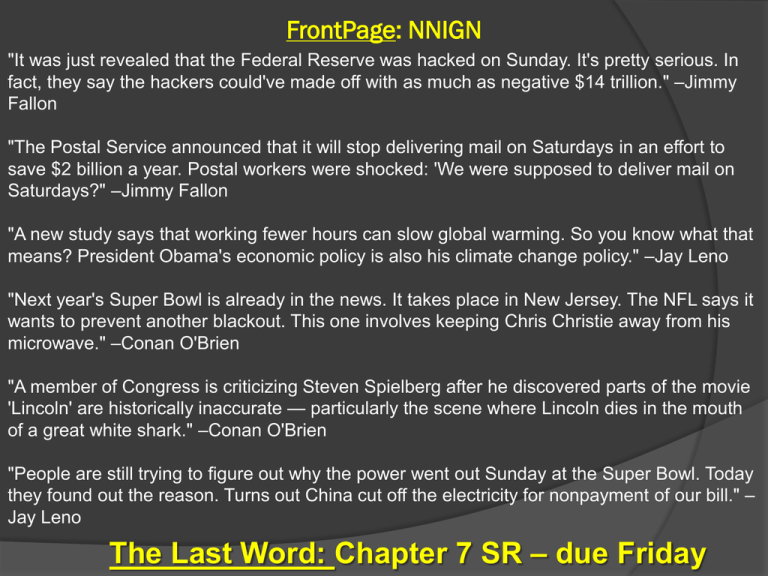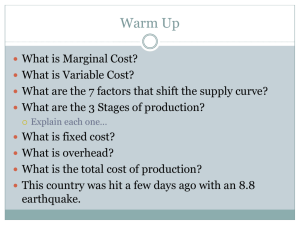Ch7 Notes
advertisement

FrontPage: NNIGN "It was just revealed that the Federal Reserve was hacked on Sunday. It's pretty serious. In fact, they say the hackers could've made off with as much as negative $14 trillion." –Jimmy Fallon "The Postal Service announced that it will stop delivering mail on Saturdays in an effort to save $2 billion a year. Postal workers were shocked: 'We were supposed to deliver mail on Saturdays?" –Jimmy Fallon "A new study says that working fewer hours can slow global warming. So you know what that means? President Obama's economic policy is also his climate change policy." –Jay Leno "Next year's Super Bowl is already in the news. It takes place in New Jersey. The NFL says it wants to prevent another blackout. This one involves keeping Chris Christie away from his microwave." –Conan O'Brien "A member of Congress is criticizing Steven Spielberg after he discovered parts of the movie 'Lincoln' are historically inaccurate — particularly the scene where Lincoln dies in the mouth of a great white shark." –Conan O'Brien "People are still trying to figure out why the power went out Sunday at the Super Bowl. Today they found out the reason. Turns out China cut off the electricity for nonpayment of our bill." – Jay Leno The Last Word: Chapter 7 SR – due Friday Chapter 7 Section 1 - Demand The “Marketplace” Consumers influence the price of goods in a market economy. Demand is how people decide what to buy and at what price. Supply is how sellers decide how much to sell and what to charge. A market represents actions between buyers and sellers. Voluntary Exchange The seller sets the price. The buyer agrees to the product and price through the act of purchasing product. Supply and demand analysis is a model of how buyers and sellers behave in the marketplace. The Law of Demand Demand is created only when the customer is both willing and able to buy product. As price goes up, quantity demanded goes down. As price goes down, quantity demanded goes up. Real income effect is when people are limited by their income as to what they can purchase. Substitution effect is when people can replace one product with another if it satisfies the same need. The Law of Demand Utility is the ability of any good or service to satisfy consumer wants. People will purchase additional items until the satisfaction from the last unit is equal to the price. The lessening of this satisfaction with each additional purchase is called diminishing marginal unity. Section 2 – The Demand Curve and Elasticity of Demand Graphing the Demand Curve A demand schedule is a table of prices and the quantity demanded at each price. It lists quantity demanded at different prices A demand curve graphs the quantity demanded of a good or service at each possible price. Quantity Demanded vs. Demand A change in quantity demanded is caused by a change in the price of a good. If something other than price causes demand to increase or decrease, this is known as a change in demand and shifts the demand curve. Determinants of Demand Population Income Tastes and preferences, including fads Substitutes are when a new competitor is added or an old competitor leaves the market. Complementary goods are products that rely upon one another, demand for one affects demand for the other. The Price Elasticity of Demand How much consumers respond to a given change in price is elasticity. Elastic demand occurs when the demand for some goods is greatly affected by the price. Inelastic demand occurs when the demand for some goods is less affected by price. How many substitutes exist and how closely they provide the same quality and service affects elasticity of demand (fewer or no substitutes make demand inelastic). The Price Elasticity of Demand Percent of a personal budget spent on that item affects elasticity of demand (the higher the percent of budget, the more elastic the demand). How much time consumers have to adjust to the new price affects elasticity of demand (more time makes for greater elasticity). FrontPage: NNIGN Los Angeles Residents Politely Ask LAPD Not To Shoot Them The Last Word: Chapter 7 GR – due Friday Section 3 – The Law of Supply and the Supply Curve The Law of Supply Supply is the willingness and ability of producers to provide goods to the consumer. As prices rise, the quantity supplied generally rises. As prices fall, the quantity supplied falls. A direct relationship exists between price and quantity supplied. The Incentive of Greater Profits Increase in price and increase in production leads to an increase in profits. Higher prices encourage more competitors to join the market. Higher prices turn potential suppliers into actual suppliers, adding to the total output. The Supply Curve Graphs and tables can explain the law of supply. A supply schedule shows the quantity supplied at each given price. A supply curve graphs the quantities supplied at each possible price. The relationship between quantity and price is direct and always moving in the same direction. Quantity Supplied vs. Supply A change in quantity supplied is caused by a change in price. Something other than price can cause a change in supply as a whole to increase or decrease. The Determinants of Supply The price of inputs, or the cost of production—raw materials, wages, insurance, utilities, etc.—can cause increase in supply. Competition, or the number of companies in an industry, can cause an increase in supply. An increase in taxes can cause a decrease in supply. An improvement in technology, or the science used to develop new products or methods of production and distribution, can cause an increase in supply. The Law of Diminishing Returns Adding units to increase production increases total output for a limited time period. The extra output for each additional unit will eventually decrease. Businesses will continue to add units of a factor of production until doing so no longer increases revenue Section 4 – Putting Supply and Demand Together Equilibrium Price In the real world, demand and supply work together. The price at which the supply meets the demand—where the two curves intersect—is the equilibrium price. Shifts in Equilibrium Price If the demand curve shifts due to something other than price, the equilibrium price will change. If the supply curve shifts due to something other than price, the equilibrium price will change. Prices Serve as Signals Rising prices signal producers to make more and consumers to purchase less. Falling prices signal producers to make less and consumers to purchase more. Shortages occur when the quantity demanded (at equilibrium price) is greater than quantity supplied. Surpluses occur when the quantity supplied (at equilibrium price) is greater than quantity demanded. Market forces can cause the prices to rise or fall to correct shortages and surpluses. Price Controls Price ceilings are a maximum price set by the government to prevent prices from going above a certain level. Items in short supply might be rationed. Shortages can lead to a black market, or illegal places to purchase such products at exorbitant prices. Price floors are minimum prices also set by the government to prevent prices from going below a certain level. Price floors set minimum wage levels and support agricultural prices.









